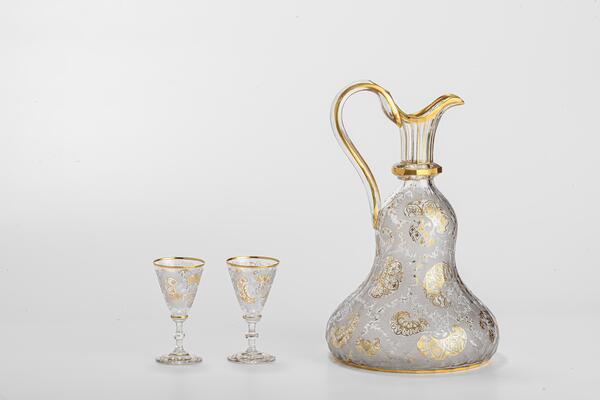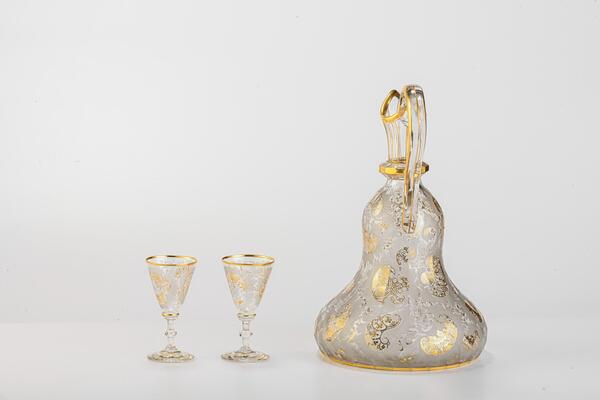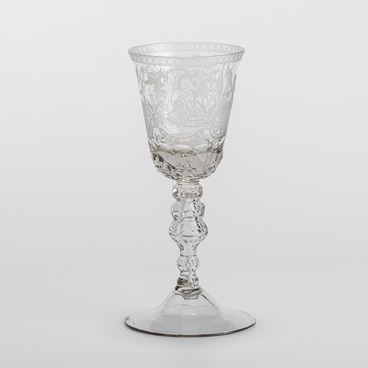The collection of the Museum of Glass and Crystal has three times more artworks compared to the ones that are presented. Only a part of the unique glassware products that were designed in the 20th century, the items donated to the museum, and the collection of Western European samples is on display. The only completely open branch of the exhibition contains the works created at the Nikolsko-Bakhmetevsky factory in the 18th and 19th centuries.
Sometimes they include glassware of a rather uncommon style, for example, this set consisting of a decanter and two glasses. The pear-shaped jug, its high curved handle and low narrow neck with a multifaceted knob at the base look unusual. The edge of the throat is curved, the spout is noticeably protruded.
The jug is cut in “scales” and flat narrow facets, decorated with gold and matte engraving. The same pattern is repeated on the body of the jug and on the top of both glasses: these are “shells” made of decorative scrolls with “tongues”, a golden ornament, scattered flower bushes and twigs.
Similar features, characteristic of the oriental style, appeared in the products of the Nikolsko-Bakhmetevsky factory after 1832. It was then that the owners of various Russian glass factories received an invitation from the Department of Manufactories to trade with the eastern regions. This market was then already under the control of France, Germany and Bohemia. The invitation was accompanied by descriptions and images of glassware made in Germany.
An exemplary price list also offered a range of popular products. These included, first of all, smooth and gilded hookahs, with carvings and gilding, then smooth and gilded jugs, various mugs, “glasses” for baths and harems for perfumes and incense waters, flower vases, cups with lids, cups for rinsing and other items.
The eastern market was especially famous for its demand for colorless glass, milk glass with gilding and painting, smooth and cut. Light green, light and dark blue glass stood out from the color scheme.
Nikolay Alekseevich Bakhmetev, the heir and second owner of the plant, accepted the invitation and launched the production of items with an oriental design. Until the revolution in 1917, the Bakhmetevsky factory supplied these items to the Persian market.
The museum’s collection contains a variety of products of this period: these are simple smooth hookahs, and elaborate goblets with complex cutting and rich paintings.
Sometimes they include glassware of a rather uncommon style, for example, this set consisting of a decanter and two glasses. The pear-shaped jug, its high curved handle and low narrow neck with a multifaceted knob at the base look unusual. The edge of the throat is curved, the spout is noticeably protruded.
The jug is cut in “scales” and flat narrow facets, decorated with gold and matte engraving. The same pattern is repeated on the body of the jug and on the top of both glasses: these are “shells” made of decorative scrolls with “tongues”, a golden ornament, scattered flower bushes and twigs.
Similar features, characteristic of the oriental style, appeared in the products of the Nikolsko-Bakhmetevsky factory after 1832. It was then that the owners of various Russian glass factories received an invitation from the Department of Manufactories to trade with the eastern regions. This market was then already under the control of France, Germany and Bohemia. The invitation was accompanied by descriptions and images of glassware made in Germany.
An exemplary price list also offered a range of popular products. These included, first of all, smooth and gilded hookahs, with carvings and gilding, then smooth and gilded jugs, various mugs, “glasses” for baths and harems for perfumes and incense waters, flower vases, cups with lids, cups for rinsing and other items.
The eastern market was especially famous for its demand for colorless glass, milk glass with gilding and painting, smooth and cut. Light green, light and dark blue glass stood out from the color scheme.
Nikolay Alekseevich Bakhmetev, the heir and second owner of the plant, accepted the invitation and launched the production of items with an oriental design. Until the revolution in 1917, the Bakhmetevsky factory supplied these items to the Persian market.
The museum’s collection contains a variety of products of this period: these are simple smooth hookahs, and elaborate goblets with complex cutting and rich paintings.





